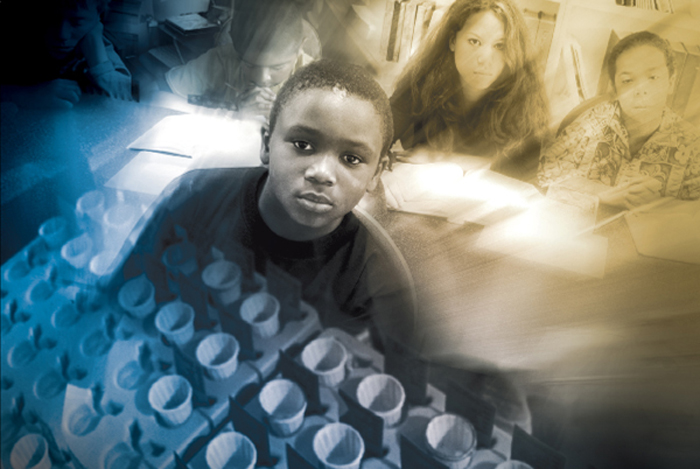Rev. Fred Shaw says Minority Mental Health Month may send African American parents a wrong message: that the effects of racial injustice require psychotropic drugs but recent studies link them to brain damage and suicide.
By CCHR International
The Mental Health Industry Watchdog
July 14, 2020
July is National Minority Mental Health Awareness Month and the Citizens Commission on Human Rights International (CCHR), a mental health industry watchdog, warns parents to be wary of psychotropic drugs recommended for their children. Civil unrest in response to deadly restraints and brutality against African Americans disproportionately affects communities of color, according to the Substance Abuse and Mental Health Services Administration (SAMSHA). But two recent studies reinforce the dangers of antidepressants and antipsychotics that may be prescribed to “treat” this impact.
CCHR says that early 1900s eugenics—the dehumanizing psychological theory that certain races of color were not as “well born” as whites, claimed to justify their sterilization, segregation or elimination. It was couched in seemingly benign terms while hiding a nefarious agenda.[1] CCHR argues that today, eugenics is repackaged as “mental health care” where African Americans, Latinos and other minorities’ normal reactions to oppression, tyranny and inflicted emotional pain through racism, is disingenuously diagnosed as a “mental illness.” Consequently, you see an over-representation of antipsychotic drug use among African Americans and harmful psychotropic drugs prescribed to African American children as young as 18 months.[2]
“Psychotropic drugging does not ‘cure’ or even change racism while proffered antipsychotics are just a prescription for brain damage,” Rev. Frederick Shaw, a CCHR spokesperson said. A study published in JAMA Psychiatry in July said the use of antipsychotics (in this case, olanzapine) was associated with damage to the brain in multiple areas. The researchers used a randomized, controlled trial design, which allows them to suggest that the drugs cause the observed effect on the brain. The researchers found “widespread” cortical [outer layer of brain] thinning in those who took the drug versus those who took a placebo.
- The researchers also confirmed that antipsychotics carry dangerous side effects, not least of which is the risk of sudden death that is substantially higher in children.[3]
- Brain atrophy (shrinkage) has been reported in children taking antipsychotics.[4]
Concerns about increasing suicide attempts among African American youth should include the “treatment” given them, which can include antidepressants that cause suicidal behavior.
A June 2020 Australian study published in Frontiers in Psychiatry refutes prominent U.S. and Australian mental health organizations claiming antidepressants reduce the risk of suicide. The researchers report: “From 2008 to 2018, Australian per-capita child, adolescent and young adult antidepressant dispensing (0–27 years old) and suicide (0–24 years) rates have increased approximately 66% and 49%, respectively.” Additionally, “there was a 98% increase in intentional poisonings among 5 to 19-year-olds in New South Wales and Victoria between 2006 and 2016, with substantial overlap between the most commonly dispensed psychotropics and the drugs most commonly used in self-poisoning. These results do not support claims that increased antidepressant use reduces youth suicide risk.”[5]
The researchers are also critical of an Australian youth mental health services programs, headspace, which also treats Aboriginal and Torres Strait children. Stanford Psychiatry’s Center for Youth Mental Health and Wellbeing sees headspace as a model for the U.S. and has been piloting it since 2017, writing: “Part of our proposed response to the mental health challenges facing American youth is to develop” a headspace model.[6]
But headspace is linked to an over-use of antidepressants. Targeting 12 to 25 year-olds, it was co-founded in Australia by two prominent psychiatrists Patrick McGorry and Ian Hickie.[7] Both have had substantial financial links to numerous pharmaceuticals companies.[8] An audit of prescribing practices at one clinic highlighted that “the majority of young people (74.5%) were prescribed an antidepressant before an adequate trial of psychotherapy was undertaken and that less than 50% were monitored for depression symptom improvement and antidepressant treatment emergent suicide related behaviors (35% and 30% respectively).[9]
ABC News spoke to young Australian Indigenous people who found headspace services did not meet their needs. “I went twice to headspace because I had issues with depression, but they didn’t really help at all,” Cody said.[10] “Really, to sum it all up, headspace was just a waste of time,” 14-year-old Jahnesta said. After years of government investment in headspace, doctors, social workers and former clients have urged the Australian Government to stop opening new clinics and consider the shortcomings of the model, according to ABC News.[11]
CCHR reinforces the need to ban physical and chemical restraints on those admitted to psychiatric facilities. Associated Press reported that Detroit-area attorney Geoffrey Fieger released a video of 16-year-old African American, Cornelius Frederick, being restrained by seven staff for about 12 minutes at Sequel facility Lakeside Academy in Michigan. The death was ruled a homicide after an autopsy found Frederick died of asphyxia.[12] Fieger stated: “The mechanism for dealing with children in this facility was abuse and fear. In fact, suffocation was regularly practiced upon children. They called it ‘fearing.’”[13]
Parents can find information to assist them in making more informed decisions about their children’s healthcare needs on FightforKids.
References:
[1] https://www.nature.com/scitable/topicpage/human-testing-the-eugenics-movement-and-irbs-724/
[2] https://www.theodysseyproject21.top/2014/12/21/black-academic-holocaust-psychotropic-drugs-black-students/
[3] Voineskos, A. N., Mulsant, B. H., Dickie, E. W., Neufeld, N. H., Rothschild, A. J., Whyte, E. M., Flint, A. J. (2020). Effects of antipsychotic medication on brain structure in patients with major depressive disorder and psychotic features: Neuroimaging findings in the context of a randomized placebo-controlled clinical trial. JAMA Psychiatry. Published online, 26 Feb. 2020, https://www.madinamerica.com/2020/07/randomized-controlled-trial-confirms-antipsychotics-damage-brain/
[4] Ibid.
[5] Martin Whitely, et al., “Antidepressant Prescribing and Suicide/Self-Harm by Young Australians: Regulatory Warnings, Contradictory Advice, and Long-Term Trends,” Frontiers in Psychiatry, 5 June 2020, https://www.frontiersin.org/articles/10.3389/fpsyt.2020.00478/full
[6] https://med.stanford.edu/content/dam/sm/psychiatry/documents/initiatives/allcove/headspacepilotoverview.pdf
[7] Op. cit., Martin Whitely, et al., Frontiers in Psychiatry
[8] Ibid.
[9] Ibid.
[10] “Headspace is ‘easy for politicians’, but failing Australia’s youth, experts say,” ABC News, 27 Aug. 2019, https://www.abc.net.au/news/2019-04-28/headspace-failing-australias-youth-experts-say/11039776
[11] Ibid.
[12] “Video shows 7 staffers restraining, sitting on teen before his death at Michigan youth facility,” AP, 8 Jul. 2020, https://www.chicagotribune.com/midwest/ct-nw-michigan-teen-cornelius-fredericks-death-20200708-khja2idbyzcnbhfpnys3gcipne-story.html
[13] Ibid.


